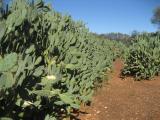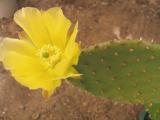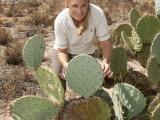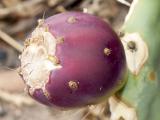Species features
Tiger pear (Opuntia aurantiaca)
| | |
Appearance
Low spreading shrub to 0.5 metres tall. Branches prostrate to somewhat erect.
Pads or segments: dark green to dark purple. Flattened, sometimes rounded, up to 20 centimetres long. Easily detached. No tubercles.
Flowers: yellow to orange-yellow.
Fruit: fleshy, globular shaped, to three centimetres long. Red-purple. Sterile.
Spines: usually two to three spines, one to three centimetres long. Brown-yellowish.
Agricultural and economic impact
Dangerous to livestock.
Riverina pear (Opuntia elata)
| | |
Shrubby plant with erect branches to two metres tall.
Pads or segments: glossy green, sometimes with a purple tinge, especially around areoles and margins. Often more than two centimetres thick, five to 25 centimetres long.
Flowers: orange.
Fruit: club shaped, to 6 centimetres long. Purplish red.
Spines: spines absent, or one to three short spines present at some areoles. Whitish yellow.
Opuntia elatior
|
| |
Shrubby, forming dense, much branched clumps five metres tall.
Pads or segments: olive green. Oblong shaped, 10-40 centimetres long.
Flowers: orange-red.
Fruit: egg shaped. Reddish when ripe.
Spines: two to eight spines, two to four centimetres long. Needle-like. Dark brown.
Opuntia engelmannii (No ‘official’ common name, sometimes called Engelmann pear/prickly pear)
| | |
Low shrub to 1.5 metres tall. Forms dense clumps. Can be confused with O. robusta but has a low, creeping habit and pads do not have a milky blue-green appearance.
Pads or segments: green. Flattened, round to egg shaped, 15-20 centimetres long.
Flowers: yellow.
Fruit: fleshy, to seven centimetres long. Purple. Almost spineless.
Spines: one to six spines, one to four centimetres long. Yellowish.
Indian fig (Opuntia ficus-indica)
| | |
Large shrub/tall tree to five metres tall. Usually with a trunk.
Pads or segments: dull blue-green. Flattened, egg to oblong shape, 20-60 centimetres long.
Flowers: yellow.
Fruit: to 10 centimetres long. Yellow, orange, red, purple.
Spines: spines usually absent, rarely one.
Bunny ears, teddy bear cactus, golden bristle cactus (Opuntia microdasys)
| |
|
Branched shrub, forming thickets to one metre tall.
Pads or segments: green to pale green and velvety. Round to oblong shaped, 6-15 centimetres long. Distinctive clusters of yellow glochids. Some cultivated forms have white or reddish glochids.
Flowers: yellow.
Fruit: fleshy, globular shaped, to three centimetres long. Red-purple. Sterile.
Spines: spines usually absent, rarely one.
Drooping tree pear (Opuntia monacantha)
| | |
Erect shrub to two metres tall, sometimes with a short trunk. Plant has an obvious drooping appearance.
Pads or segments: glossy green. Oblong to egg shaped, thin profile, 10-30 centimetres long.
Flowers: yellow or orange-yellow.
Fruit: pear shaped, to seven centimetres long. Red. Spineless.
Spines: one to two spines, two to four centimetres long. Brown to off-white.
Opuntia aff. polyacantha
| | |
Erect branching shrub 0.5-2m tall
Pads or segments: light to mid-green. Oblong to egg shaped, thin profile, 12-22 centimetres long.
Flowers: yellow.
Fruit: 2.5-4 centimetres long. Deep red. Sometimes forming chains of fruit.
Spines: 6-14 spines per areole, one to five centimetres long. Straw-coloured to pale brown.
Wheel cactus (Opuntia robusta)
| Opuntia robusta cacti |
|
|
Appearance
Shrubby /tree-like to two metres tall. Many branches.
Pads or segments: blue green. Circular shape, thick profile, to 40 centimetres wide.
Flowers: yellow.
Fruit: fleshy, globular shaped, to eight centimetres long. Deep red. Numerous fertile seeds.
Spines: two to 12 spines, up to five centimetres long. White to pale brown or yellow.
Agricultural and economic impact
A large, robust 'prickly pear' type of cactus, ideally suited to much of southern WA, birds spread the seeds. Dangerous to livestock.
Further details: for further details on Opuntia robusta visit the wheel cactus: declared pest page.
Opuntia schickendantzii (No ‘official’ common name, sometimes called chicken dance cactus)
| |
Agricultural and economic impact
Can injure livestock, contaminate wool and hides and reduce or prevent grazing.
Common prickly pear (Opuntia stricta)
| | |
Sprawling/erect shrub, up to two metres tall. Forms thickets.
Pads or segments: blue green. Egg or oblong shaped, 10-25 centimetres long.
Flowers: yellow.
Fruit: fleshy, globular to pear shaped, to six centimetres long. Purplish red. Numerous fertile seeds.
Spines: in variety stricta spines usually absent, occasionally one on pad. In variety dillenii up to 11 spines,1.5 to four centimetres long.
Velvet pear (Opuntia tomentosa)
| | |
Shrubby to treelike, up to five metres tall. Often with a trunk. Segments and fruits covered in fine hairs, giving a velvety (tomentose) appearance.
Pads or segments: oblong to egg shaped, 15-30 centimetres long.
Flowers: orange.
Fruit: globular to egg shaped, to five centimetres long. Red.
Spines: often spineless, but can have zero to four spines, 0.5-1.5 centimetres long. Whitish yellow.
Declared pest category
The Western Australian Organism List (WAOL) contains information on the area(s) in which this pest is declared and the control and keeping categories to which it has been assigned in Western Australia (WA). Search for Opuntia cacti in the WAOL by using the scientific name Opuntia.
Requirements for land owners/occupiers and other persons
Requirements for land owners/occupiers and other persons if this pest is found can be sourced through the declared plant requirements link.
Search > detect > report
| MyPestGuide™ Reporter | Pest and Disease Information Service (PaDIS) |
Control methods
Report the presence of this organism if it's legal status is prohibited before undertaking a control measure. Control methods for these declared plants can be found through the opuntioid cacti control link.
Further Information
For more information on cacti, download the Opuntioid cacti best practice control manual.




